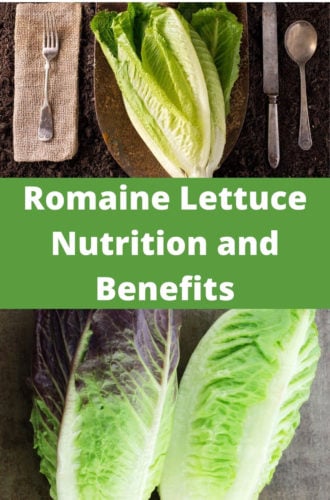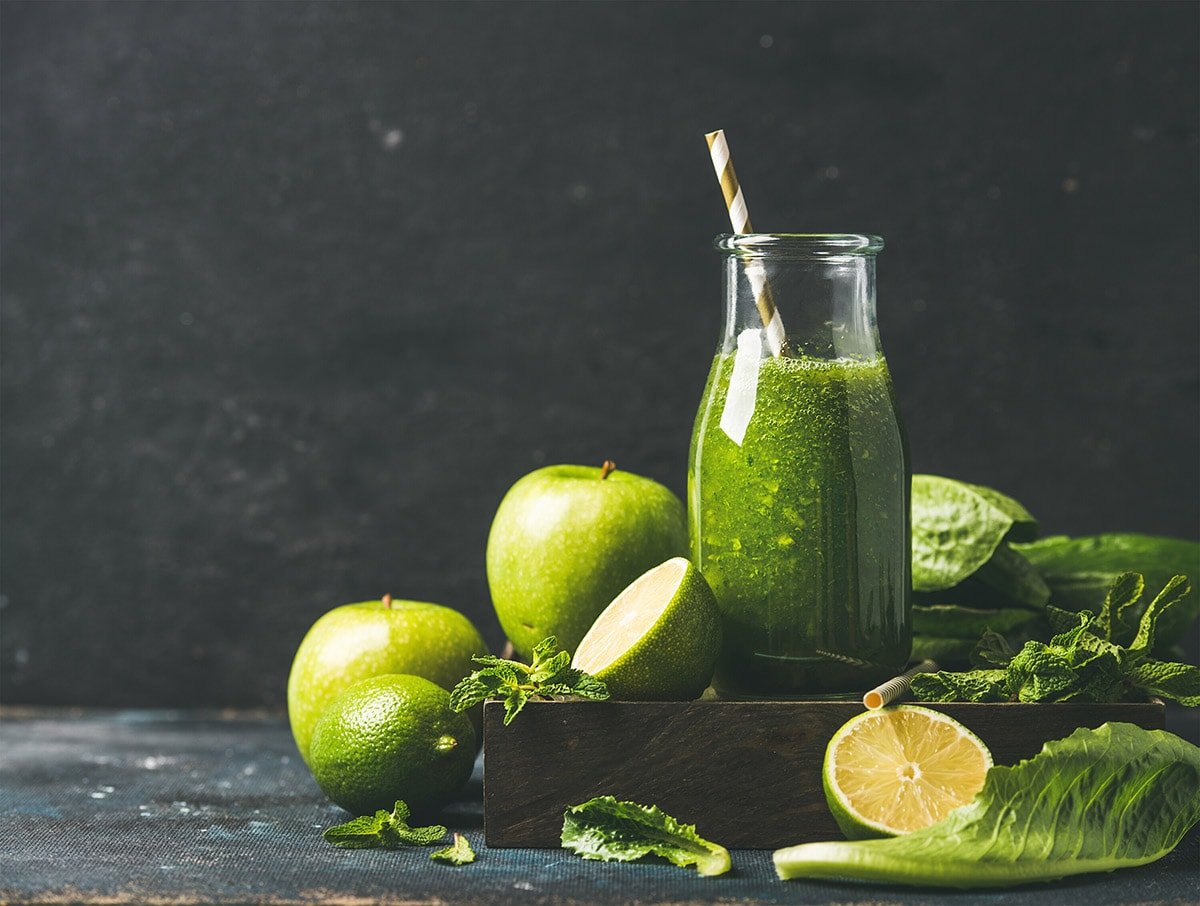Romaine Lettuce Nutrition and Benefits
Romaine lettuce is more than just the nice green garnish that you toss on your Caesar salad; it’s actually one of the healthiest vegetables around. Whether you choose to eat romaine lettuce raw or enjoy it in a variety of delicious dishes, romaine lettuce nutrition packs some great stuff into its leaves. It’s loaded with many vitamins and minerals that are essential to your body’s well-being.
Here’s more on romaine lettuce nutrition and how it can benefit your health.
Also see, How To Grow Lettuce, Butter Lettuce, and Miner’s Lettuce.



What is Romaine Lettuce?
Romaine lettuce is a leafy green, crunchy, nutrient-dense vegetable with long, cylindrical leaves, commonly used in Caesar salads, regular salads, and lettuce wraps.
Romaine lettuce, also known as cos lettuce, originated in the Mediterranean region, but today it’s cultivated around the world and used in salads everywhere. It’s prized not only for its flavor but also for its nutritional value, which includes plenty of vitamin A and many other vitamins and minerals. Romaine lettuce is available year-round at most grocery stores and farmers’ markets, making it an ideal salad base or sandwich filler during any season.
Romaine Lettuce Nutrition
Unlike other leafy greens, particularly kale and spinach, romaine lettuce is low in calories but high in water content. This may make it seem like it has no nutritional benefits, but studies have proven it all wrong.
Romaine lettuce is high in vitamins, minerals, and phytonutrients, which can significantly benefit your health.

According to the United States Department of Agriculture, One cup (47 grams) of romaine lettuce contains:
- Water:6 grams
- Protein:6 grams
- Calories: 8
- Fiber: 1gram
- Carbohydrates:5 grams
- Fat:1 gram
- Vitamin K:2 micrograms, or 60 percent of daily requirements
- Vitamin A: 4,094 international units, or 82 percent of daily requirements
- Vitamin C:3 milligrams, or 19 percent of daily requirements
- Folate:9 micrograms, or 16 percent of daily requirements
- Calcium:5 milligrams, or 2 Percent of daily requirements
- Manganese: 0.1 milligrams, or 4 percent of daily requirements
- Potassium: 116 milligrams, or 3 percent of daily requirements
- Iron:5 milligrams, or 3 percent of daily requirements
These nutrients may promote good health in different ways.
Romaine Lettuce Health benefits
1. Improves bone density
The minerals in romaine lettuce, including iron, magnesium, copper, phosphorus, and manganese, work to promote bone health.
It’s also high in vitamin K, which has been shown to enhance the production and activation of prothrombin, a protein that facilitates minerals to bind to the bones, to perform their functions. This helps build strong bones and prevent osteoporosis.
In one study, vitamin K was shown to help increase bone mineral density and lower the risk of fractures in individuals with osteoporosis.
Vitamin K also regulates the coagulation profile by preventing excessive bleeding and controlling clotting processes.
2. Enhancing vitamin A intake
With just 2 ounces providing 100 percent of your daily vitamin A requirement, regular consumption of romaine lettuce may help improve eyesight, promote cell growth and development, improve immune function, and promote healthy skin.
Vitamin A also acts as an antioxidant, neutralizing free radicals in the body that may undergo oxidative stress. This may lead to inflammation, reduced immunity, and cell mutations causing disease formation.
3. Boosting heart health
Romaine lettuce is high in folate, which plays a vital role in converting the amino acid homocysteine into methionine. High levels of homocysteine in the blood may cause damage to your blood vessel lining, cause plaque formation, and increase the risk for heart disease.
Potassium, vitamin A and C in romaine lettuce also help regulate blood pressure and prevent cholesterol buildup. This will help maintain cardiovascular health and lower the risk for stroke, heart attack, and heart disease.
4. Boosting immunity
Romaine contains high levels of vitamin A and C, powerful antioxidants known for their ability to boost the immune system. Vitamin C mainly boosts the immune system by improving digestive health, increasing nutrient absorption and utilization, and reducing inflammation.
On the other hand, Vitamin A improves the immune system by protecting the skin against oxidative damage, regulating gene expression, fighting infections, and improving digestive health.
Romaine lettuce may greatly contribute to your daily vitamin C requirements as the body does not store or make its own; thus, you can only get it from food.
5. Improving digestive health
The high fiber content in romaine aids digestion, normalizes bowel movements, and prevents constipation.
It also acts as a prebiotic, feeding the good gut bacteria. This improves gut flora, which promotes general gut health, and brain health.
To enhance the digestive benefits of this fiber, ensure you are drinking adequate amounts of water.
7. Regulates blood glucose levels
Romaine lettuce is generally low on the glycemic index, and even so, the high fiber content helps regulate glucose release into the blood.
Eating romaine salad with other meals high in carbohydrates may help slow digestion and maintain a steady release of sugar, keeping you energized until your next meal.
7. Aids weight loss
Romaine’s high fiber content keeps you full for longer, which helps prevent unnecessary snacking that may contribute to weight gain.
Its high water content also helps you feel full quicker.
Add romaine lettuce salad to your lunch or dinner to enhance your weight loss journey.
8. Prevents cataracts
Vitamin A in Romaine lettuce may help prevent age-related cataracts, thus improving eyesight in old age.
It also contains zeaxanthin, a compound that reduces the risk of age-related macular degeneration.
Other great sources of zeaxanthin include broccoli, kale, collard greens, and spinach.
How to Eat Romaine Lettuce
It’s hard to think of lettuce as an exciting part of any meal, but there are many ways to make romaine lettuce exciting and even delicious. Here are seven ways to eat romaine lettuce that won’t leave you longing for something more filling or flavorful.
Make a fresh vegetable salad
A salad is the most common way to eat lettuce. Simply chop romaine lettuce and place it in a salad bowl with tomatoes, cucumbers, and any other vegetables of your choice. Then dress it with olive oil and lemon juice. This is a great lunch or dinner!
Steam it
Besides making a salad, another great way to prepare romaine lettuce is by steaming it. Boil water in a large pot. While that’s heating up, remove any damaged leaves from the head of romaine, you’ll want to break off individual leaves and rinse them thoroughly in cool water.
Next, chop it into bite-sized pieces and add them to a steam basket or colander lined with cheesecloth or paper towels. Place it over your pot and cover with a lid. Steam for 2–3 minutes until slightly wilted, then season with salt and pepper. You can eat these veggies as they are or enjoy them as a side dish. You can also use them as part of another recipe like avocado salad.
Make lettuce wraps
To make lettuce wraps, simply take a large leaf of romaine lettuce and wrap it around your favorite fillings. The result is a satisfyingly crunchy, flavourful meal that will keep you feeling fuller for longer. If you don’t eat meat or are looking for vegetarian dinner ideas, try wrapping sautéed mushrooms or roasted sweet potatoes in romaine leaves with fresh herbs and salsa.
Make a sandwich
Toss some lettuce into your next sandwich for a healthy dose of vitamin A and K, fiber, and omega-3 fatty acids. Try adding slices of tomato and avocado. If you’re looking to bulk up on greens, consider swapping out half of your bread with lettuce leaves instead. Think outside of your regular sandwich routine!
Stir-fry it
Stir-frying or lightly sautéing romaine lettuce makes it a flavorful addition to many dishes.
Darker romaine leaves work better for cooking because they’re less bitter and easier to digest than lighter-colored types.
Feel free to replace greens in your favorite recipes with romaine without worrying about them overpowering your dish. Toss it in olive oil with garlic and cook over medium heat until it softens, then season with salt and pepper, or any other herb or spice you like!
Make soups
One of my favorite things about romaine lettuce is that it’s a great addition to soups. Not only does it add flavor and texture, but it also adds some much-needed nutrients, particularly when paired with another green like kale or spinach.
You will love putting romaine lettuce in gazpacho (a classic cold Spanish soup made with red onion, cucumbers, fresh tomatoes, and garlic)or broth-based soups like miso soups.
Juice it
Raw vegetables are always healthier than cooked because they’re packed with living enzymes that help boost metabolism and improve digestion. So if you’re looking for a way to bump up your intake of dark green veggies, reach for romaine lettuce juice instead of sautéing them in oil.
Mix it into smoothies
Tired of eating your vegetables plain? You can easily incorporate leafy greens into your favorite smoothie. If you’re not a big fan of spinach or kale, start with romaine lettuce since it adds a subtle taste that blends well with most fruits.
Romaine Lettuce Storage Tips
The best way to store romaine lettuce is in an airtight container in your refrigerator crisper. This will help keep it fresh and prevent it from going bad too quickly.
As with many other leafy greens, romaine lettuce should be washed before you store it—wash it, dry it off and wrap it in paper towels before placing it in a sealable plastic bag or an airtight container in your refrigerator.
If your lettuce does get a little wilted, don’t throw it out! You can refresh it by soaking it in ice water for 10 minutes or so. You can also place leaves on top of each other and wrap them tightly in plastic wrap; they’ll rehydrate within 24 hours.
You can also add lemon juice or apple cider vinegar—both will help retain freshness longer.
Risk and side effects
Bacterial contamination
Romaine lettuce is an extremely healthy vegetable; however, it has had several recalls due to its link to foodborne disease outbreaks like Escherichia coli and Salmonella.
This is especially true if they are grown on contaminated soil or irrigated with contaminated water.
Romaine lettuce is also generally susceptible to bacteria because it grows close to the ground, retains moisture, and is often eaten raw.
Heavy metal absorption
Another concern is the fact that romaine lettuce can pull heavy metals from the soil.
When consumed, the metals can pose a great health risk to the consumer.
Eating homegrown or organic lettuce is a great way to lower such risks.
Also, wash your vegetables under running water, even pre-washed ones, and always use a separate chopping board to cut them.
Also, wash your hands before and after handling vegetables.
Other Related Articles
- Kiwi Nutrition And Benefits
- 11 Proven Health Benefits Of Goji Berries
- Top 5 Best Beans To Eat
- Benefits Of Blueberries And Raspberries
- Cucumber Nutrition
In conclusion
Romaine lettuce nutrition is packed with many health benefits, and if you’re not already including it in your diet, now might be the time to start.
With its fresh taste and crunchy texture, romaine lettuce gives you the ability to add more greens to your diet with fewer calories than many other types of vegetables, as well as plenty of vitamins, minerals, and antioxidants that can help protect your body from serious diseases like cancer and cardiovascular disease.
Regular consumption may also help enhance vitamin A intake, improve bone density, aid weight loss, regulate blood sugars, improve eyesight, and prevent age-related cataract formation.
There are various interesting ways to increase your romaine lettuce consumption, including steaming, sautéing, lettuce wraps, sandwiches, smoothies, juices, and soups.
There has been romaine lettuce recalls in the past several decades due to contamination with Salmonella and E. coli. Growing your own or buying organic will always lower the risk of any possible contamination. Also, ensure you are cleaning your vegetables well and handling them with high hygiene standards to prevent any home-based contamination.

If you enjoyed this article on Romaine Lettuce Nutrition and Benefits and would love to see more, join me on Youtube, Instagram, Facebook & Twitter!
Get discounted copies of my cookbook here.
Fortunately, because of the Ads on our website, readers and subscribers of Healthier Steps are sponsoring many underprivileged families.







Thank you for sharing these benefits